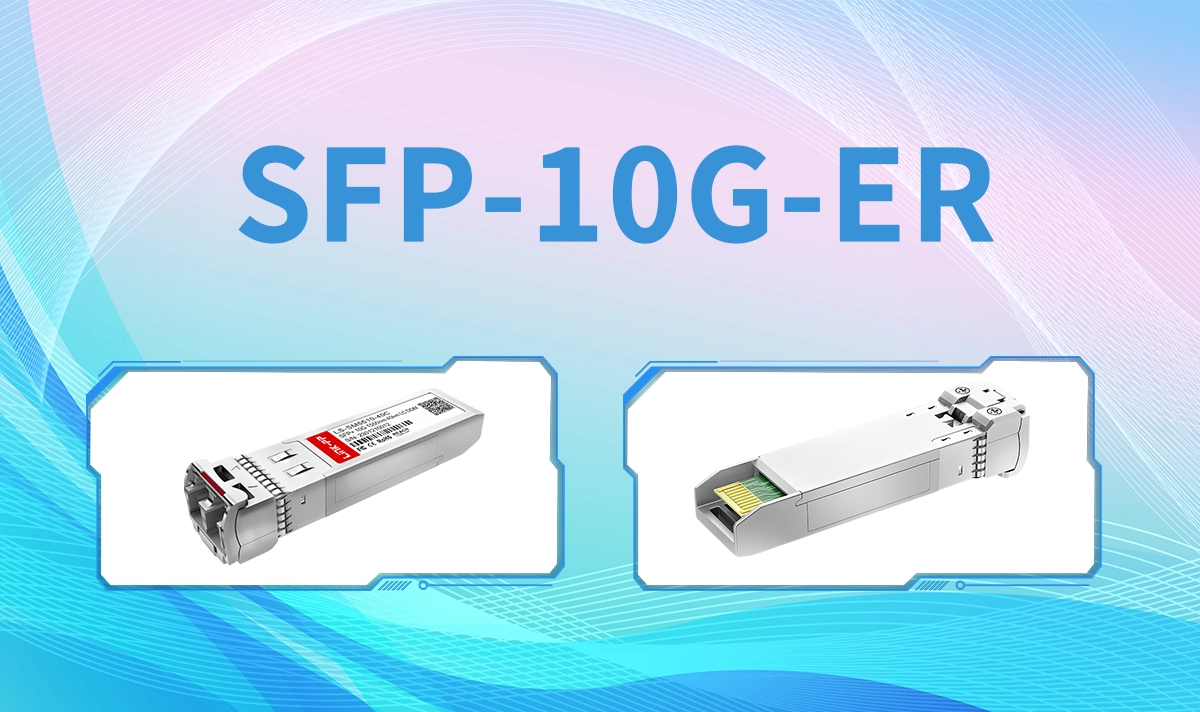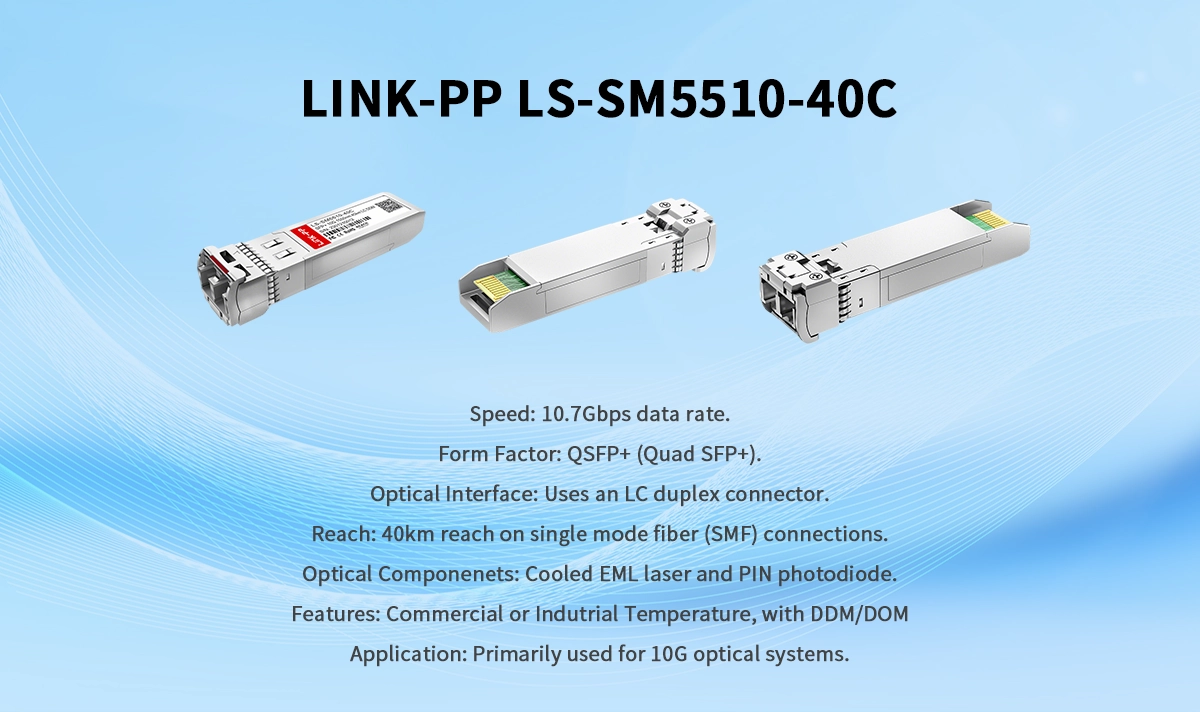
This comprehensive guide dives deep into the SFP-10G-ER optical transceiver module. Learn its technical specifications, key applications, compatibility nuances, advantages over other 10G optics, and best practices for deployment. Discover how the LINK-PP SFP-10G-ER delivers reliable, cost-effective long-reach 10 Gigabit Ethernet solutions for demanding network infrastructure.
➤ Key Takeaways
The SFP-10G-ER transceiver moves data at 10Gbps. It works over single-mode fiber for up to 40km. This makes it good for long network connections.
It uses a 1550nm wavelength and LC duplex connectors. These help keep signals strong. You can swap it easily without turning off devices.
The module works with many Cisco and other brands’ devices. But you should check if your device and firmware are compatible before using it.
Install the SFP module the right way and clean connectors often. This helps the module work well and stops signal loss or network problems.
Always buy real SFP-10G-ER modules from trusted sellers (like LINK-PP). Fake products can hurt your network’s performance.
➤ Powering the Distance: The Critical Role of SFP-10G-ER Modules
In the relentless pursuit of higher bandwidth and extended reach for network infrastructure, the SFP-10G-ER optical module remains a cornerstone technology for 10 Gigabit Ethernet (10GbE) deployments requiring distances beyond standard SR or LR optics. This hot-pluggable SFP+ transceiver is engineered to transmit 10Gbps data streams over single-mode fiber (SMF) for link lengths up to 40 kilometers, making it indispensable for metro Ethernet, campus backbone networks, enterprise data center interconnects (DCIs), and telecom access networks.
Understanding the intricacies of this 10G optical transceiver is crucial for network engineers, data center managers, and IT procurement specialists aiming to build robust, scalable, and cost-efficient optical networks. This guide provides the technical depth and practical insights needed for optimal implementation.
SFP-10G-ER: Core Technical Specifications
The SFP-10G-ER conforms to the IEEE 802.3ae 10GBASE-ER standard. Its defining characteristic is its use of 1550nm wavelength laser technology. This longer wavelength, compared to the 1310nm used by LR/LRM or 850nm used by SR optics, experiences significantly lower signal attenuation (loss) over standard single-mode fiber (G.652). This physics principle is what enables the impressive 40km reach.
Here’s a breakdown of its key technical parameters:
Feature | Specification | Importance |
|---|---|---|
Form Factor | SFP+ (Small Form-factor Pluggable Plus) | Hot-pluggable, compact design for high port density. |
Standard | IEEE 802.3ae 10GBASE-ER | Guarantees interoperability with compliant networking equipment. |
Data Rate | 10.3125Gbps (10 Gigabit Ethernet) | Supports high-speed data transmission. |
Wavelength | 1550nm | Low attenuation in SMF enables the 40km reach. |
Fiber Type | Single-Mode Fiber (SMF), G.652 | Requires standard OS1 or OS2 single-mode cabling. |
Max Distance | Up to 40 kilometers | Solves long-haul connectivity challenges within campuses/metros. |
Connector | Duplex LC | Industry-standard, reliable fiber optic connector. |
DDM/DOM Support | Yes (Digital Optical Monitoring) | Enables real-time monitoring of Tx/Rx power, temperature, voltage. Crucial for network diagnostics and proactive maintenance. |
➤ Why Choose SFP-10G-ER? Key Applications & Advantages
Bridging Campus & Metro Distances: Seamlessly connect buildings across large university campuses, corporate headquarters, or industrial parks far exceeding the 10km limit of LR optics. Eliminate the need for expensive intermediate equipment.
Cost-Effective Data Center Interconnect (DCI): Link geographically adjacent data centers (up to 40km apart) for replication, backup, or workload balancing without investing in higher-rate (and more expensive) coherent DWDM solutions prematurely.
Service Provider Access & Aggregation: Extend high-speed 10G services (business Ethernet, mobile backhaul) from central offices (COs) or points of presence (PoPs) to customer premises or cell towers within the 40km radius.
Future-Proofing Fiber Plant: Utilizing the same standard single-mode fiber (OS2) as longer-reach or higher-speed future technologies (e.g., 100G ER4 Lite, coherent optics) protects your cable infrastructure investment.
Overcoming SR/LR Limitations: Provides the essential reach where SFP-10G-SR (max ~300m on OM3/OM4 MMF) and SFP-10G-LR (max 10km on SMF) fall short. It's the logical step for 40km SMF links.
SFP-10G-ER Compatibility: Avoiding Pitfalls
Compatibility is paramount when sourcing 10G ER SFP+ modules. While adhering to the MSA (Multi-Source Agreement) ensures physical and electrical compatibility, transceiver compatibility with specific switch, router, or server brands often involves firmware checks and vendor-specific coding.
Brand Lock-In: Major OEMs (Cisco, Juniper, HPE Aruba, Brocade, Arista) often implement systems (like Cisco's PID check) that reject third-party modules unless they are precisely coded. This is where 100% compatible MSA modules from reliable suppliers like LINK-PP become essential for cost savings.
The LINK-PP Advantage: The LINK-PP SFP-10G-ER module LS-SM5510-40C is rigorously programmed and tested to ensure seamless OEM compatibility across a wide range of platforms. We guarantee full DOM support and plug-and-play functionality, offering a reliable, high-performance alternative to costly OEM-branded 10G ER optics.
Transmitter Power & Receiver Sensitivity: Ensure modules meet the standard's minimum Tx power and Rx sensitivity specs (-4.7dBm to +4.0dBm Tx; -15.8dBm Rx sensitivity @ BER) for reliable 40km operation. High-quality modules undergo stringent optical testing.
➤ SFP-10G-ER vs. SFP-10G-ZR: Understanding the 40km vs. 80km Choice
A common point of comparison is the SFP-10G-ZR module. While both operate on 1550nm SMF, key differences exist:
Reach: ZR optics target 80km distances.
Standard: ZR is not an official IEEE standard but an industry MSA extension. ER is IEEE-standardized (10GBASE-ER).
Laser Type & Cost: Achieving 80km typically requires higher-powered, more expensive cooled DFB lasers and often more complex dispersion compensation considerations. ER modules use uncooled DFBs, making them generally more cost-effective for 40km deployments.
Use Case: Choose SFP-10G-ER for proven, standardized 40km performance. Opt for SFP-10G-ZR only if you genuinely require the extended 80km reach and understand its non-standardized nature and potentially higher cost/power consumption. For pure 40km SMF 10G links, ER is the optimal, standards-based optical transceiver solution.
➤ Best Practices for Deploying SFP-10G-ER Modules
Fiber Type Verification: Confirm the path uses OS1 or OS2 single-mode fiber (G.652). Multimode fiber (MMF) is incompatible and will not work.
Link Loss Budget Calculation: Before deployment, calculate the total expected optical loss (dB) of your fiber link. Include:
Fiber attenuation (dB/km - typically 0.25dB/km max for OS2 @ 1550nm * distance)
Connector losses (typically 0.3dB per mated pair)
Splice losses (typically 0.1dB per splice)
Margin (3-5dB recommended). Ensure the total loss is LESS than the module's specified power budget (Min Tx Power - Min Rx Sensitivity). For 40km, ensure adequate margin exists.
Laser Safety: SFP-10G-ER modules use Class 1M or Class 1 laser products. Avoid looking directly into the fiber ports or connectors when the module is powered. Use dust caps when unplugged.
Handling & Cleaning: Treat fiber optic modules with care. Always use clean LC connectors and ensure fiber end-faces are meticulously cleaned with appropriate tools (clicker cleaners, lint-free wipes, inspection scope) before insertion. Dirty connectors are a leading cause of link failures and performance degradation.
DOM Monitoring: Utilize DOM data (accessible via device CLI/GUI or SNMP) to monitor real-time Tx/Rx power. Compare these values against the module's specifications to verify healthy operation and identify potential issues like deteriorating connectors or fiber stress before they cause outages. This is critical for network monitoring and troubleshooting optical links.
➤ Why Choose LINK-PP for Your SFP-10G-ER Needs?

At LINK-PP, we specialize in manufacturing high-performance, reliable compatible optical transceivers, including our flagship LS-SM5510-40C. We understand the critical nature of your network links.
Guaranteed Compatibility: Our modules are precisely coded for seamless integration with leading OEM switches and routers.
Rigorous Quality Control: Every module undergoes extensive testing (including full optical parameter verification and DOM functionality) to meet or exceed MSA and IEEE standards.
Cost Savings: Achieve significant savings compared to OEM pricing without compromising on performance or reliability for your 10G ER SFP+ deployments.
Lifetime Warranty & Expert Support: Backed by a comprehensive lifetime warranty and supported by our team of optical networking specialists.
Upgrade Your Network Reach Today with Confidence
The SFP-10G-ER transceiver module is the proven, standards-based workhorse for extending 10 Gigabit Ethernet up to 40km over cost-effective single-mode fiber. Whether you're connecting campus buildings, establishing metro links, or implementing DCI, understanding its capabilities and deployment best practices is key to success.
Ready to deploy reliable, high-performance SFP-10G-ER optics at the best value?
Explore the LINK-PP LS-SM5510-40C Datasheet & Request a Quote Today!
LINK-PP: Your Trusted Partner for High-Quality, Compatible Optical Modules and Fiber Optic Solutions.
➤ See Also
The Essential Guide to SFP-10G-LR Optical Transceivers




